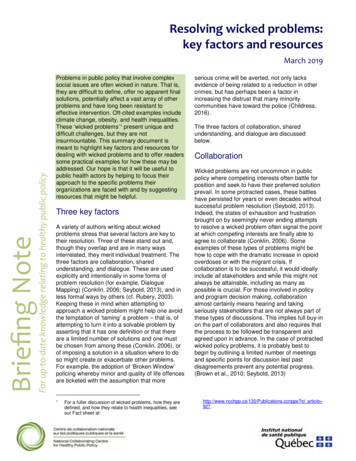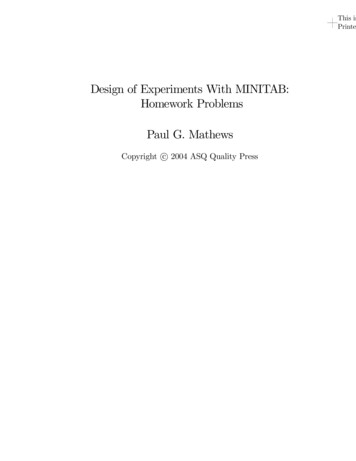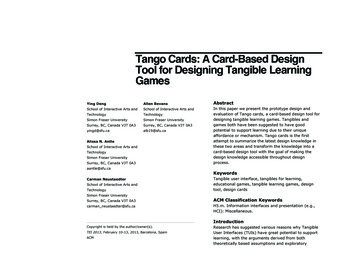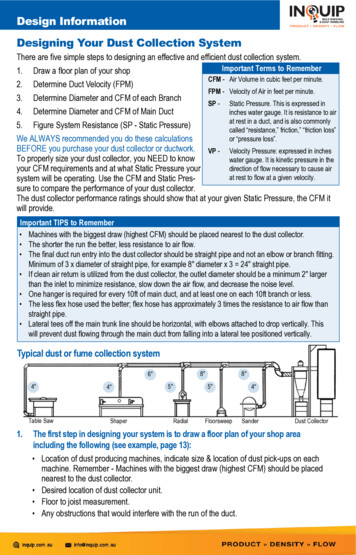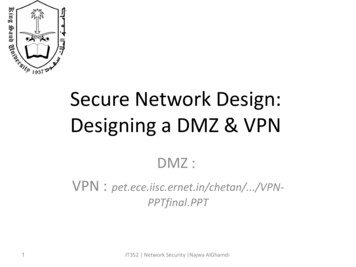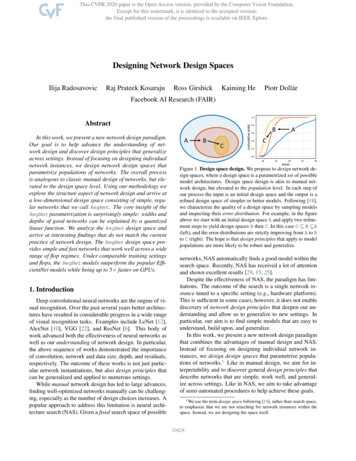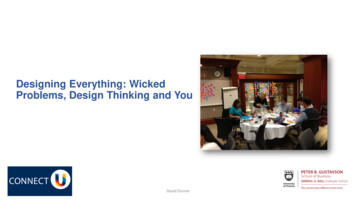
Transcription
Designing Everything: WickedProblems, Design Thinking and You2017-05-12David Dunne1
Summary: designing everythingDesign thinking is a unique, nonlinear approach to problemsIt is particularly suited to tough challenges: wicked social problems; innovation Its key strength is its emphasis on reframing: solving the right problemIt is in increasing use in industry, government, education, healthcare where it can be challenging to implement, but best practices are emergingWe are starting to implement it at Gustavson, in our courses and approaches to problems.Watch for more to come.2017-05-12David Dunne2
Gerwin Hoogendoorn’s Senz of design2017-05-12David Dunne3
What is Design?2017-05-12David Dunne4
What is Design Thinking?2017-05-12David Dunne5
With a partner What is creative tension?Come up with an example of creative tension2017-05-12David Dunne6
Design thinking is about creative tensionReframePosition 12017-05-12CompromiseDavid DunnePosition 27
How I see creative tensionHMW do both?Economy2017-05-12Tradeoffsbetween jobsandenvironmentDavid DunneEnvironment8
Design Thinking is a MethodIt emphasizes framing problems, through synthesisIt emphasizes deep understanding of users andcontext, through ethnographyIt emphasizes making, through rapid prototypingIt is iterativeIt is reflectiveIt can be messy2017-05-12David Dunne9
It’s a method suited to ‘wicked’ problemsWicked problems are those with with nobeginning, no end, where the questionsoverwhelm the answersThe problem with wicked problems isdefining the problem (framing the problemspace)How to deal with crime in the streets;terrorism; obesityMost of the work in design thinking is inproblem framing, which makes it suited forwicked problems2017-05-12David Dunne10
https://vimeo.com/903555412017-05-12David Dunne11
Design thinking is a way of being in the world(Weltanschauung; Dasein)It is humble: we don’t know the answer, or even the rightquestionIt is optimistic: there is a solution and we will find itIt is open and flexible: mind of a childIt is curious: everything in the world needs fixingIt is focused on thoughtful action: reflective practice2017-05-12David Dunne12
It’s a way of approaching problems in the world thatbegins from a point of optimism, that there is asolution, and it’s a matter of us reaching it. It builds onthat with this idea of ‘mind of a child’, with this ability tobe open to whatever the world is going to tell you, andcoupling that with this idea of an attitude of wisdom.Being able to recognize evidence for what it is andacting upon it.2017-05-12David Dunne13
It’s a way of approaching problems in the world thatbegins from a point of optimism, that there is asolution, and it’s a matter of us reaching it. It builds onthat with this idea of ‘mind of a child’, with this ability tobe open to whatever the world is going to tell you, andcoupling that with this idea of an attitude of wisdom.Being able to recognize evidence for what it is andacting upon it.2017-05-12David Dunne14
Some interesting things design thinkers have done2017-05-12David Dunne15
How GE is turning an MRI into an experience for kids (andsaving money too)http://www.youtube.com/watch?v 16p9YRF0l-g2017-05-12David Dunne16
A new ‘broom’ from P&G2017-05-12David Dunne17
Swiffer and creative tension2017-05-12David Dunne18
The University of Technology Sydney designs out crime2017-05-12David Dunne19
Visiting some Design Thinking labs2017-05-12David Dunne20
There are several municipal, provincial and federalgovernment labs – in Victoria and across aldelivery/service-design2017-05-12David Dunne21
City Studio Victoria is acollaborative environment forco-creation and avid Dunne22
P&G’s clay street: a home away from home2017-05-12David Dunne23
MindLab’s government office in Copenhagen2017-05-12David Dunne24
Or try MindLab’s The Mind2017-05-12David Dunne25
Or IDEO’s yurt2017-05-12David Dunne26
The classroom of the future?Rotman Designworksand Sauder d.studio2017-05-12David Dunne27
Your turn2017-05-12David Dunne28
How should universities respond to online education?HMW Rethink themeaning of highereducation?Business asusual2017-05-12Put somecoursesonlineDavid DunneGo completelyonline29
Could design thinking work at Uvic?You receive a 500,000 grant to start a Design Thinking lab at Uvic, with a mandate toaddress the disruption of the university education model.2017-05-12David Dunne30
Creative TensionsHow design thinkers work in organizations2017-05-12David Dunne31
If design thinking’s so great, why isn’t everybody doing it?Design thinking is widely misunderstoodThey’re not willing to sit in the question,not willing to chew it on it a little orrevisit for a while . They really quicklyjump to “We want this finished, we wantto move on,” as opposed to actuallytaking the time to prototype, reframe, gothrough the iterations.It risks being dismissed as a managementfadMany have tried and many havefloundered: they face 3 tensions2017-05-12David Dunne32
My journey 30 interviews with experts and design leaders in the private, nonprofit and public sectorsThe organizations were spread across Europe, the US, Canada and AustraliaThe interviews were conducted onsite whenever I could; otherwise by Skype or phoneMy initial goal was to understand how designers used learning to tackle wicked problemsHowever I found patterns that had more immediate interest: many of the labs were dealing with issues oftheir own survival in organizations and had to find responses2017-05-12David Dunne33
Why do organizations get into design thinking?Facilitate innovation: from ‘hand grenade’ to Post-Its’Disruptive’ innovation: ‘transform the experience and delivery ofhealth care’Cultural change: ‘innovative, nimble, responsive to change’Complement to strategy: ‘people on the ground’Perspective change: ‘inside-out to outside-in’Well, the strategy’s reallyinteresting and we’ve had a fewbreakthroughs, but is it changinganything for people on theground?” So there was that humanelement or tangible element wewere looking for that pure strategytype thinking wasn’t giving us.Collaboration: ‘collaborate, don’t consult’System integration: ‘nobody experiences the tax system’2017-05-12David Dunne34
Another reason:2017-05-12David Dunne, Ph.D.
Design Thinkers face three tensions1.The Tension of Inclusion2.The Tension of Disruption3.The Tension of PerspectiveThese are called tensions because they are not ‘solved’ by making tradeoffs. They neverreally go away.2017-05-12David Dunne36
The Tension of Inclusion: being in and out at the same timeHMW Build the Mindset?Too supportDavid DunneToo ‘out’Isolated andeasily forgotten37
Don’t be a crazy cowboyYou have to spend sometime within the organizationand get to know the playersand the politics, and thedrivers of what they’re doing.They can’t be cowboys orcowgirls and just dowhatever the hell they want.2017-05-12David Dunne38
The Australian Tax Office’s ‘diffused’ approachWe built all these islands ofcapability through theorganization that were stitchedtogether by the brand of“design”, but they weren’tcentrally funded. I just knewthat if it was a target it probablywouldn’t have a long shelf life.2017-05-12David Dunne39
The Tension of Disruption: being incremental and disruptiveHMW designplatforms, notproducts?Too ‘incremental’Fighting fires,chasing shinyobjects2017-05-12Too ‘disruptive’Quick &early winsDavid DunneToo much time,too few results40
Telus’ baby steps‘People are talking about it, and there’s a buzz and we’vegot a funnel of projects, but the fragility of what we’ve builtis pervasive we are still largely influence without anyauthority’.2017-05-12David Dunne41
Why Christmas lights can spark a revolution2017-05-12David Dunne42
The Tension of Perspective: being user-centred and systemcentredHMW designfor systemsand users?Too ‘user-centred’Nothing gets implementedBlowback2017-05-12Too ‘system-centred’’Distributed’design thinkingDavid DunneIsolated andeasily forgotten43
Anonymous (Swedish) automaker: the arrogance of (some)designersThey have zero idea, they don'teven know that there's anotherworld. It's kind of like, that book:called ‘Flatland’? It's an amazingbook, written in the 1800s, it's ajourney, where you will meetpeople in different dimensions, sofirst you encounter one image. It'sjust one guy, a dot, and he doesn't[know anything about anything]2017-05-12David Dunne44
Govt of Alberta CoLab: reframing energyDesigners tend to want to leap into action andwork on something that’s really cool, that’sreally desirable to an end-user, but in doingso they can often act on a point in the systemthat’s not really strategic; it’s not going to bea leverage point. So, stepping back andmapping the system helps you to identifybetter the leverage points where design couldreally make a difference.2017-05-12David Dunne45
Reframing the tensionsReframe 1. Design Thinking as a MindsetReframe 2. Design Thinking as a PlatformReframe 3. Design Thinking for the System2017-05-12David Dunne46
Summary: designing everythingDesign thinking is a unique, nonlinear approach to problemsIt is particularly suited to tough challenges: wicked social problems; innovation Its key strength is its emphasis on reframing: solving the right problemIt is in increasing use in industry, government, education, healthcare where it can be challenging to implement, but best practices are emergingWe are starting to implement it at Gustavson, in our courses and approaches to problems.Watch for more to come.2017-05-12David Dunne47
book, written in the 1800s, it's a journey, where you will meet people in different dimensions, so first you encounter one image. It's just one guy, a dot, and he doesn't [know anything about anything] Govt of Alberta CoLab: reframing energy 2017-05-12 David Dunne 45 Designers tend to want to leap into action and work on something that’s really cool, that’s really desirable to an end-user .

